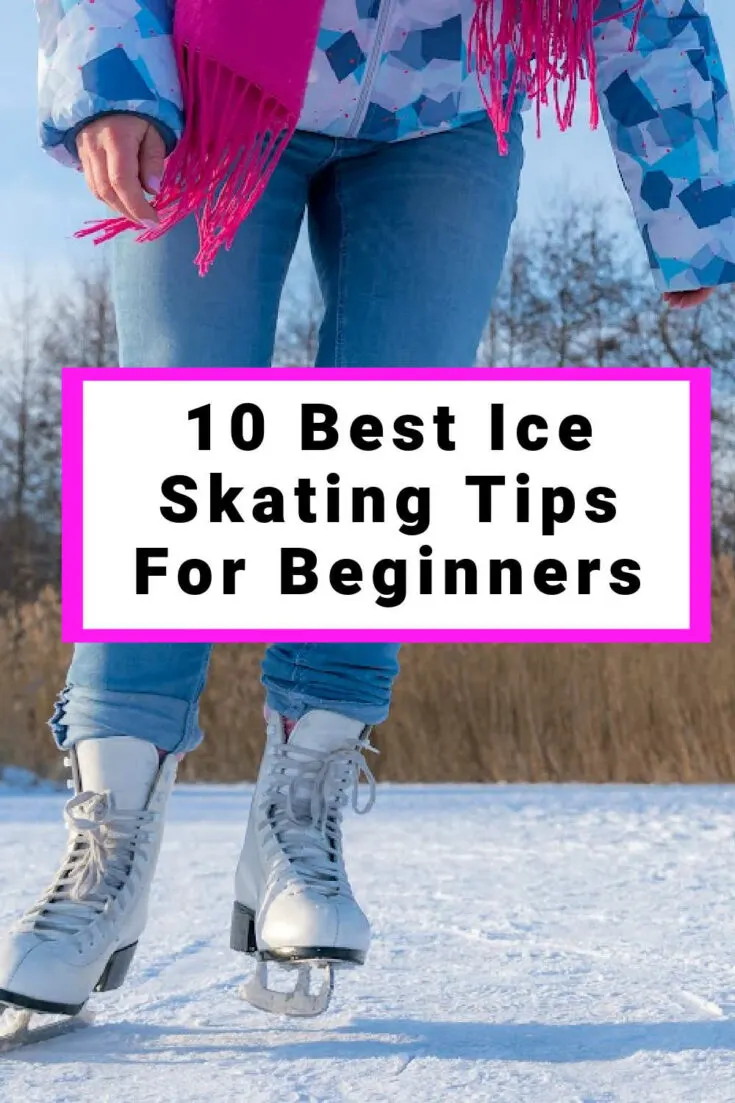Ice skating is a great way to stay active during the winter and if you want to give it a go, you’ll need these simple ice skating tips for beginners. Learn how to ice skate for the first time and make your skating as fun as possible, even if you have never been on skates before!
Although it can be daunting to head out to the ice for the first time, especially as an adult, remember that everyone was a beginner ice skater at some point! The great thing about skating is that progress is normally really fast and with regualr skating practice you will see amazing improvements in a relatively short period of time.
If you’re thinking about ice skating as a winter activity, make sure to read these tips for ice skating to get you started the right way.
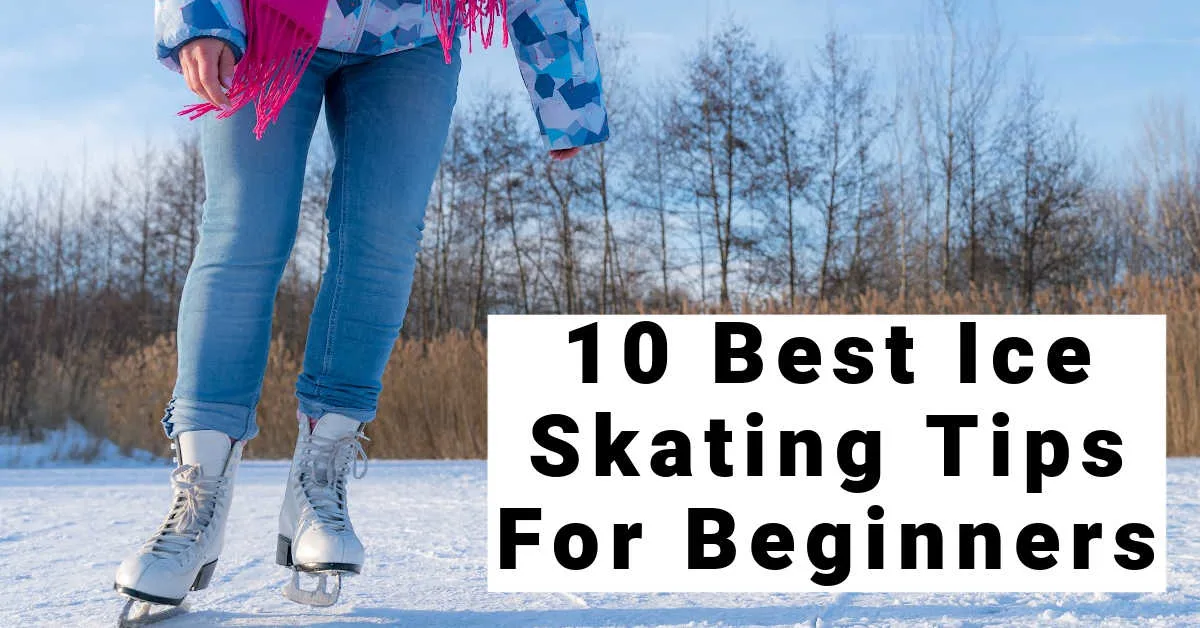
This post may contain affiliate links. Please read my Affiliate Disclosure for more information
MORE ICE SKATING TIPS FOR BEGINNERS
What To Wear Ice Skating Indoors (Top 11 Must-Haves)
Is Ice Skating Dangerous? (How to Stay Safe)
Ice Skating Tips For Beginners
Ice skating is a great way to get exercise and have fun. It is a sport that can be enjoyed by people of all ages. Ice skating is a good workout because it requires you to use your entire body. It also helps improve your balance and coordination.
In this post we will talk you through 10 essential beginner ice skating tips that will help you enjoy your first time on the ice, here is what we will learn:
- Choose the right rink
- Wear the right clothing
- Choose the right skates
- Putting your skates on properly
- Use a skate aid
- Start off slowly
- Perfect your posture
- How to stop in ice skates
- Falling down and getting up
- Getting better as a beginner skater
1. Choose the right ice skating rink
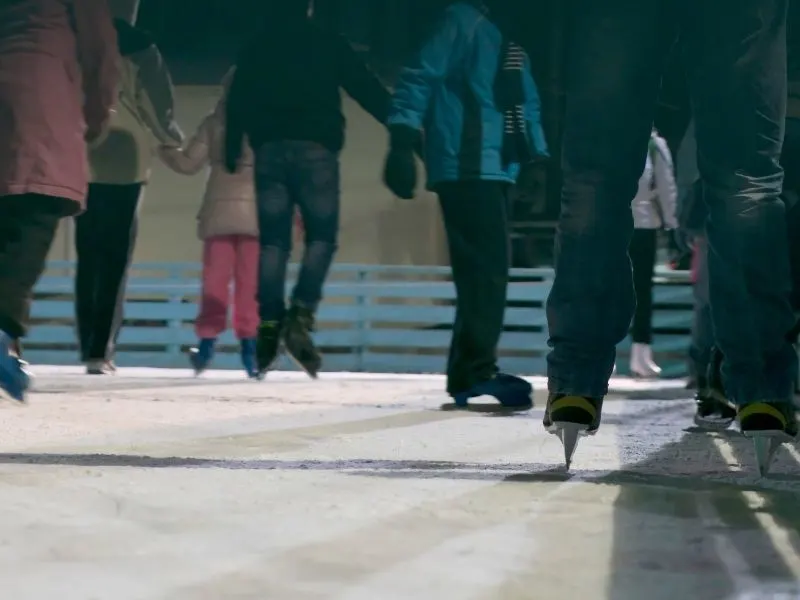
When it comes to ice skating, not all rinks are created equal. Some rinks are much better for beginners than others. If you’re a beginner, make sure to pick a rink that is smaller and has less people skating on it.
That way, you’ll be less likely to get run over by someone who is more experienced. If you go to a busy rink, you may feel nervous or stressed that people will bang into you and that will hinder your progress.
Some large rinks cordon off an area for little children and beginners – take advantage!
Another thing to consider when choosing a rink is the ice. Not all ice is the same and for the most part, an indoor rink will have smoother ice that is easier for a beginner ice skater to learn on.
Finally, make sure to check the hours of operation before you go. Not all rinks are open late at night. If you’re looking for somewhere to skate after work, make sure the rink you choose is open late.
2. Wear the appropriate clothing

In order to dress for the weather, you must first know what the weather will be like. Many people choose to dress in layers so that they can adjust as needed. This is a good way to dress for the weather because it allows you to be comfortable and not too hot or too cold.
A few tips on dressing in layers are to start with a light layer such as a T-shirt or tank top. Then, add a layer that will keep you warm such as a sweatshirt or jacket. If it is going to be colder, you can add another layer of clothing such as long pants and a hat. If it is going to be warmer, you can remove some of the clothes that you have on.
Another thing to remember when learning to skate is that a helmet is an absolute must. Head injuries are no joke and you don’t want to risk falling over and ending your skating career before it has started.
Click here for more tips on what to wear ice skating.
3. Choosing The Right Skates
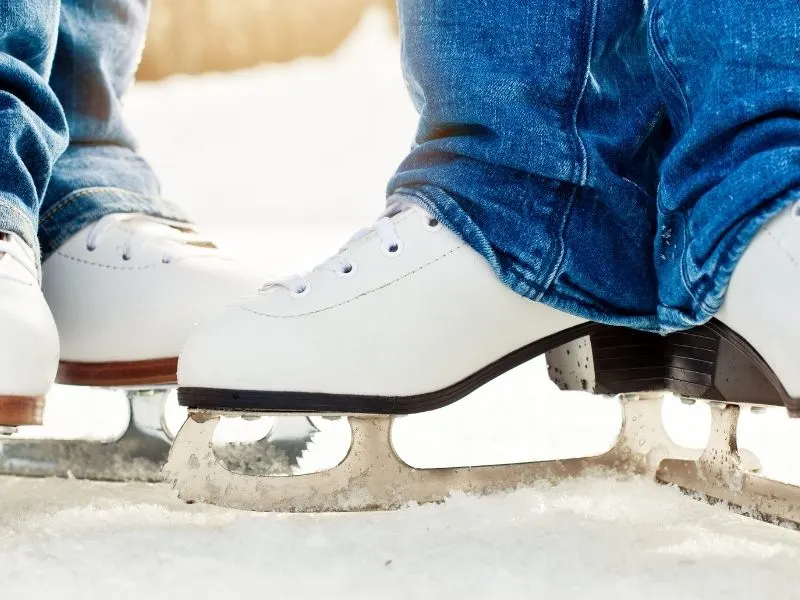
Rent or buy skates that fit: Don’t try to save money by renting skates that are too big or small.
When you’re looking to rent skates for an upcoming ice skating session, it’s important to make sure that you get a pair that fit properly. Skates that are too big will be uncomfortable and difficult to control, while skates that are too small will cause pain and blisters.
If you’re not sure what size to get, ask the staff at the rental shop for help. You may also want to consider buying your own skates, especially if you plan on skating often. Skates that fit well will provide more control and stability, making your skating experience more enjoyable.
4. Putting ice skates on properly
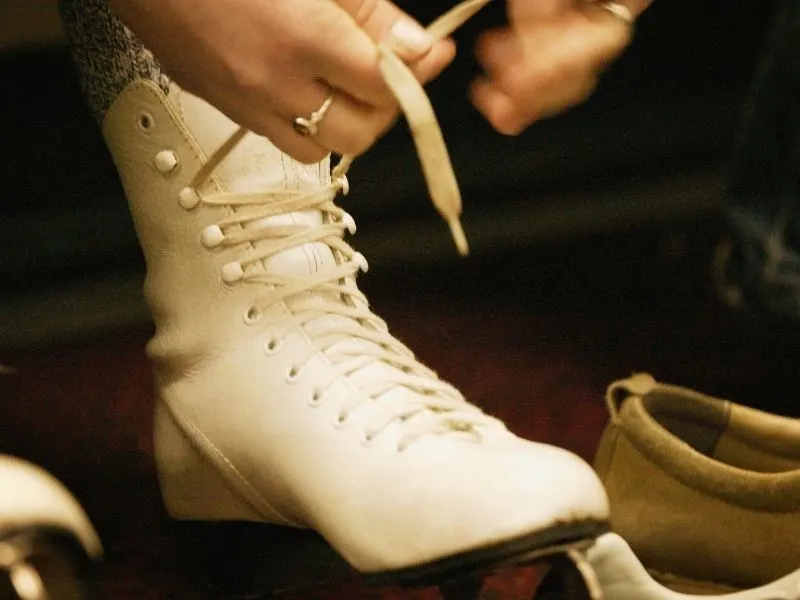
Ice skating is a popular winter activity enjoyed by many. However, if you have never put ice skates on before, it can be a bit confusing and intimidating. Here are some tips on how to put ice skates on properly so you can start enjoying this fun pastime.
First, make sure that the ice skates are the correct size for your feet. You should be able to wiggle your toes comfortably inside the boots.
Second, lace up the skates tightly so they fit snugly against your feet. They should be tighter than you would normally tie your shoes, especially around the front of your ankle.
Third, stand up and hold onto something for support as you slowly begin to walk in them. Get used to walking in your skates on dry land before you head onto the ice. Walking on a carpeted surface such as a basement floor can be a great way to get you comfortable in your skates.
5. Use an ice skating aid
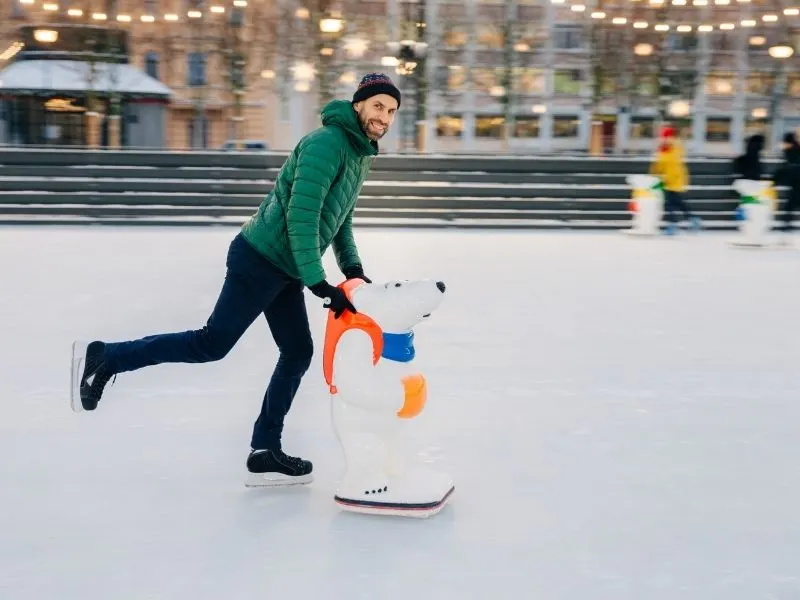
Some people believe that you should forgo the skating aids and just get on the ice but for many adult beginners, a skate aid can be useful in the early days.
There are many reasons why people might use ice skating aids. Maybe they are just starting out and need a little bit of help to keep them balanced. Or maybe they have been skating for years but their balance isn’t as good as it used to be. In any case, using ice skating aids is a great way to improve your skating skills.
You can use a real skating aid to help you but they are normally designed for kids so may be too short for an adult. You can hold onto the boards if you want something secure when you first get on the ice. I also found stroller or even a hockey net was helpful in the early days.
One of the best things about using ice skating aids is that you can still move around easily on the ice. This makes it easy to get around the rink and practice your skills.
Another advantage of using ice skating aids is that you can stay active while you are learning how to skate. This is important, because it helps keep you motivated and interested in learning.
6. Start Off Slowly

Don’t run before you can walk when it comes to ice skating. Take your time on the ice and focus on getting comfortable with wearing skates before you attempt to do any fancy moves.
Start by marching across the ice. This is how little kids are first taught to ice skate and it will help you get used to the feeling of wearing your skates. It will also help you find your balance.
Once you are comfortable with marching, try to do a push, push glide motion. You might find that one foot feels more secure than the other one, that’s normal.
After your gliding is solid, you can try to do some bubbles where you open your legs then close them as you move across the ice.
7. The perfect posture for ice skating

When you are ice skating, it is important to have the right posture. This will help you stay balanced and avoid falls. Here are a few tips to help you achieve the perfect posture:
1. Stand tall with your shoulders back and your head up. This will help you keep your balance.
2. Keep your arms close to your body. This will help you stay balanced and prevent falls.
3. Bend your knees slightly and keep your weight on the balls of your feet. This will give you stability when skating.
4. Point your toes slightly outward so that you can better grip the ice rink surface.
8. Learning to stop in ice skates
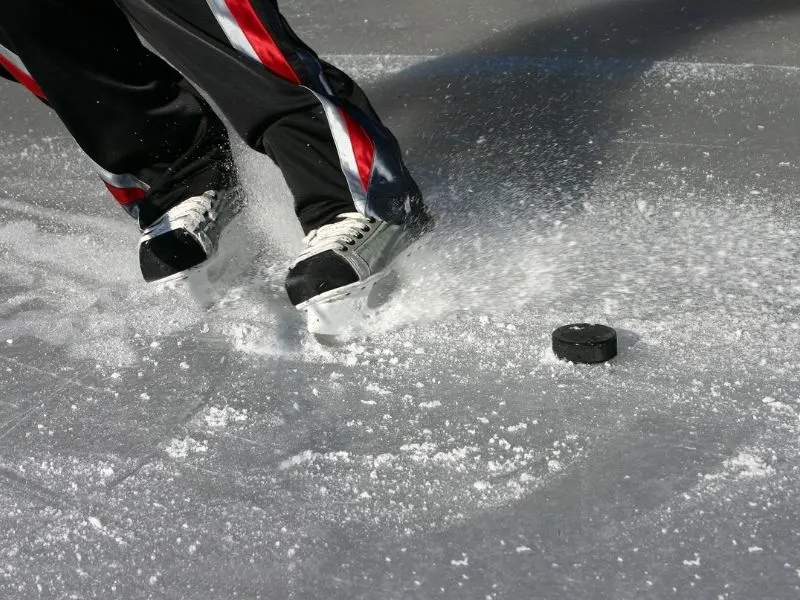
When you are skating on ice, it is important to be able to stop quickly. If you cannot stop, you may fall and injure yourself. There are several ways to stop in ice skates.
The way that you are probably familiar with is the hockey stop. To do a hockey stop, you need to be skating fast and then quickly turn your skates sideways. This will cause you to lose speed and stop quickly. Don’t attempt the hockey stop until you are a confident skater. It looks cool but is not a beginner ice skater move.
Beginners should use a snowplow stop. To do a snowplow stop, you need to be skating slowly and then turn your skates so that the tips of the blades are facing each other. Your feet should make a triangle or pizza shape.
This will cause you to lose speed and stop quickly.
9. Learn how to fall down and get up in ice skates
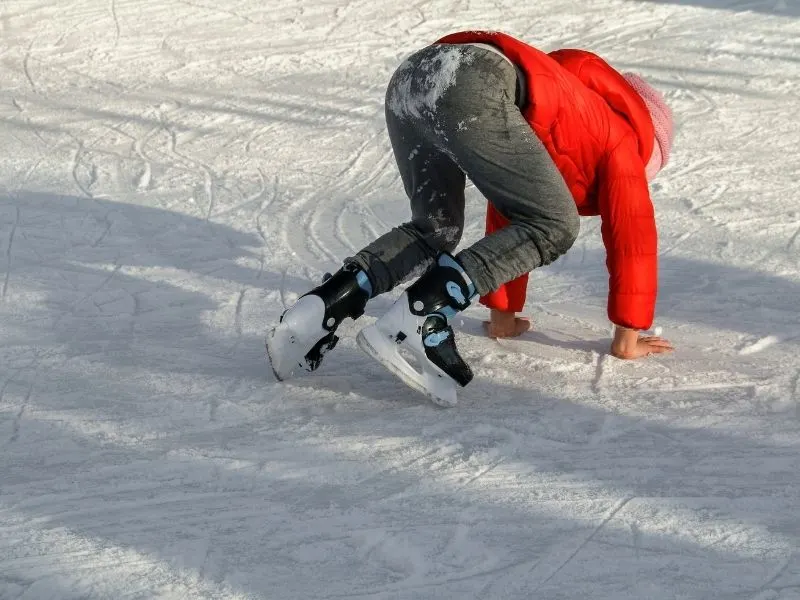
An important tip for ice skating is to learn how to fall down properly and also how to get up when you fall. The truth is, falling down is a part of learning to skate. You won’t get better unless you allow yourself to try new moves that may result in you falling down.
Learning to fall properly is key to avoiding injuries. Most ice skating injuries are caused by people using their arms to break their fall. If you can fall on your butt, that is your best option.
Once you are down on the ground, it is time to get up. Put one foot on the ice and push on that knee to get yourself back up to a standing position.
10. Practice, practice, practice: The more you skate, the better you’ll become

One of the most important ice skating tips for beginners may seem obvious but don’t ignore it.
In order to get better at skating, you have to skate as much as possible.
The more you skate, the better your techniques will become and the easier it will be to stay on your board. Try and skate at least once a week when you are starting off.
If you are able to take skating lessons, you will progress much more quickly than if you can only skate alone with no coach.
Skating also helps improve your balance and coordination. If you’re looking to improve your skating skills, make sure to practice as often as possible.
Ice Skating Tips For Beginners – Final Thoughts
Ice skating can be a fun and exhilarating experience, but it will be more fun if you are properly prepared. By following these tips for beginners, you can make your first time on the ice a safe and enjoyable one.
Have fun! Ice skating is a great way to get fit and have fun.
